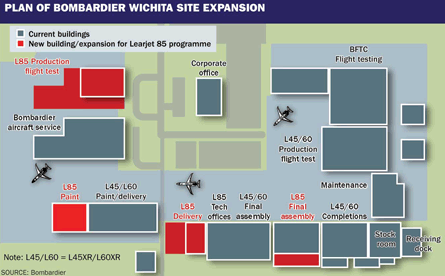Dramatic changes are under way at the Bombardier Learjet factory in Wichita as the manufacturer prepares for final assembly of the new Learjet 85.
Learjet vice-president and general manager David Coleal says that over the past 18-24 months the manufacturer has had "a strategic transformation" that completely revamps the way it does business. Lean manufacturing techniques have been introduced, resulting in new more efficient workflows and less waste.
"We've improved our on-time delivery performance from 20% to 88% in the past 18 months," Coleal says. "We've really done a good job at executing."
Coleal, a lean manufacturing expert who previously worked in the automotive industry and was responsible for introducing lean manufacturing at Cirrus Aircraft before joining Bombardier in early 2008, says the Learjet focus this year is on introducing facility improvements and layout changes. Next year he says the focus will be on introducing more elements of the lean production system, further eliminating waste and developing standardised work practices.
Having already accomplished what Coleal calls "a paradigm shift", the manufacturer aims to master lean production techniques in time for the start of Learjet 85 final assembly. Preparation for physical changes ahead of the start of Learjet 85 final assembly is also under way, including modifications to the production facility to accommodate the new programme.
Learjet 85 operations general manager Alan Young says the manufacturer has decided to locate the Learjet 85 final assembly line at the current location of the Learjet 60 final assembly line. Learjet 60 final assembly will shift and be co-located for the first time with Learjet 40/45 final assembly. "We are going to amalgamate the existing product line," Young says, adding that Learjet has completed studies to prove this is feasible.
 |
|---|
Young explains that by going to a mixed model line for the 40, 45 and 60 "space is freed up for the Learjet 85 six-position line". He says the building will have to be renovated and modified because the Learjet 85 is bigger than the Learjet 60. But he adds that the cost of the modifications pales in comparison to what it would have cost to construct a new building for Learjet 85 final assembly. "We're trying to be cost conscious," Young says.
Coleal says that a mixed model line for the existing models would not have been feasible without lean production. He explains that lean manufacturing has enabled Learjet to compress the time required to assemble aircraft, allowing it to meet production requirements for all the existing models in a smaller space. "We're trying to get our lean production thinking hats on and use as much of the existing footprint as possible," Coleal says.
While Bombardier has been able to avoid having to invest in a new final assembly building for the Learjet 85 it will be constructing new facilities to handle deliveries and painting. The new Learjet 85 delivery facility will be adjacent to the newly combined Learjet 40/45/60 final assembly building while the new paint hangar will be next to the paint hangar that already now handles all the existing models.
Finally, Bombardier will also open a new hangar to accommodate the Learjet 85 flight-test aircraft. This will be located on the other side of the campus and across from the Bombardier Aircraft Services complex.
Young says Wichita now has 170-180 employees - mainly engineers - working on the Learjet 85 programme. But he says this will grow "to north of 400" and "I think it will go close to 500 employees".
Young says more Learjet 85 detailed design work could be moved to Wichita from Montreal. If this is done, more engineers will be hired, which will not be difficult given the massive aerospace layoffs in Wichita this year.
"A year ago we were worried about not finding enough engineers for the programme," Coleal says, adding that given the recent turnout at local aerospace job fairs this is no longer an issue.
Learjet this year was recognised by Bombardier as its most improved business unit, but Coleal acknowledges the recognition is "a little bittersweet" given the downturn in the market, which has resulted in layoffs and several week-long factory shutdowns at Learjet. "The market demand has really shrunk. It's really unfortunate. We are really fighting for every deal as you can imagine," he says. "But I look out there and I'm really proud of what we've accomplished."
Young, who rejoined the Learjet unit last year after a stint working for Vought in Dallas, adds: "The transformation has literally been breathtaking."
Source: Flight International










































